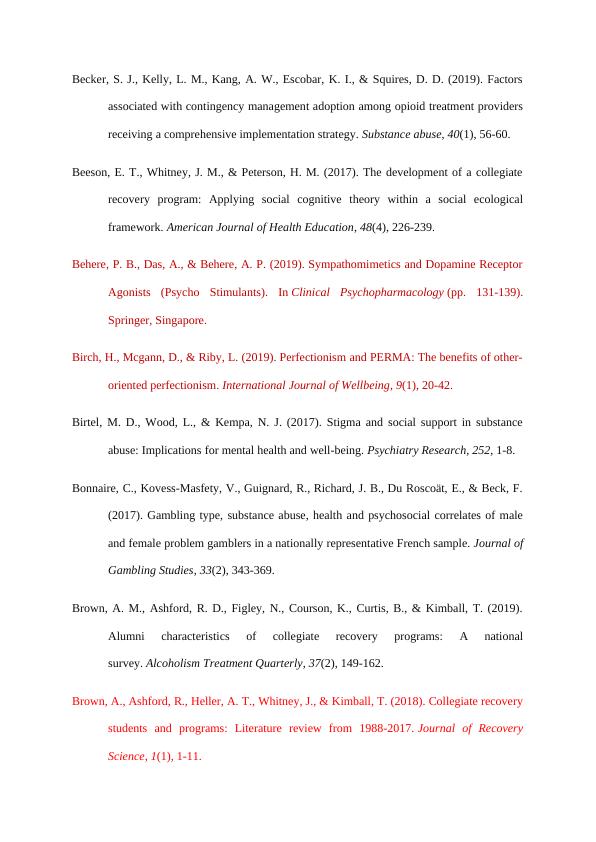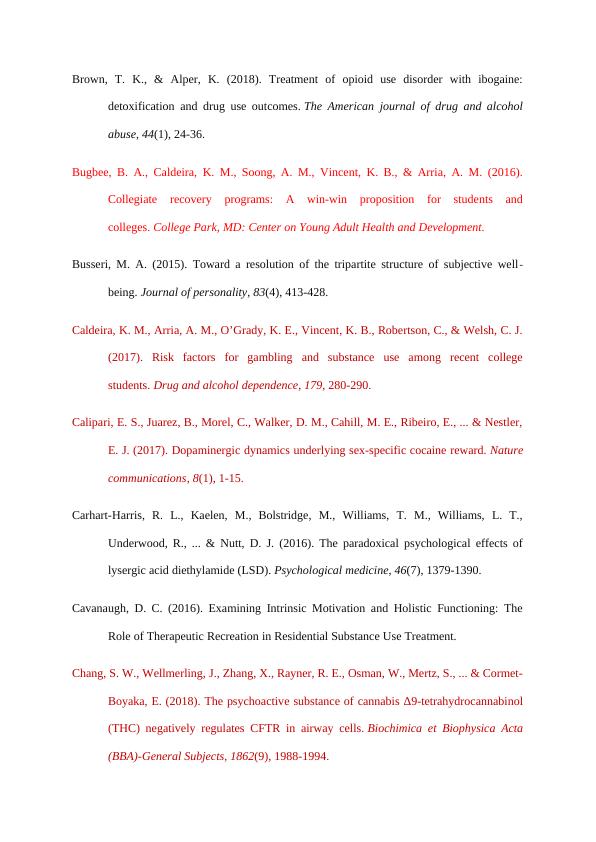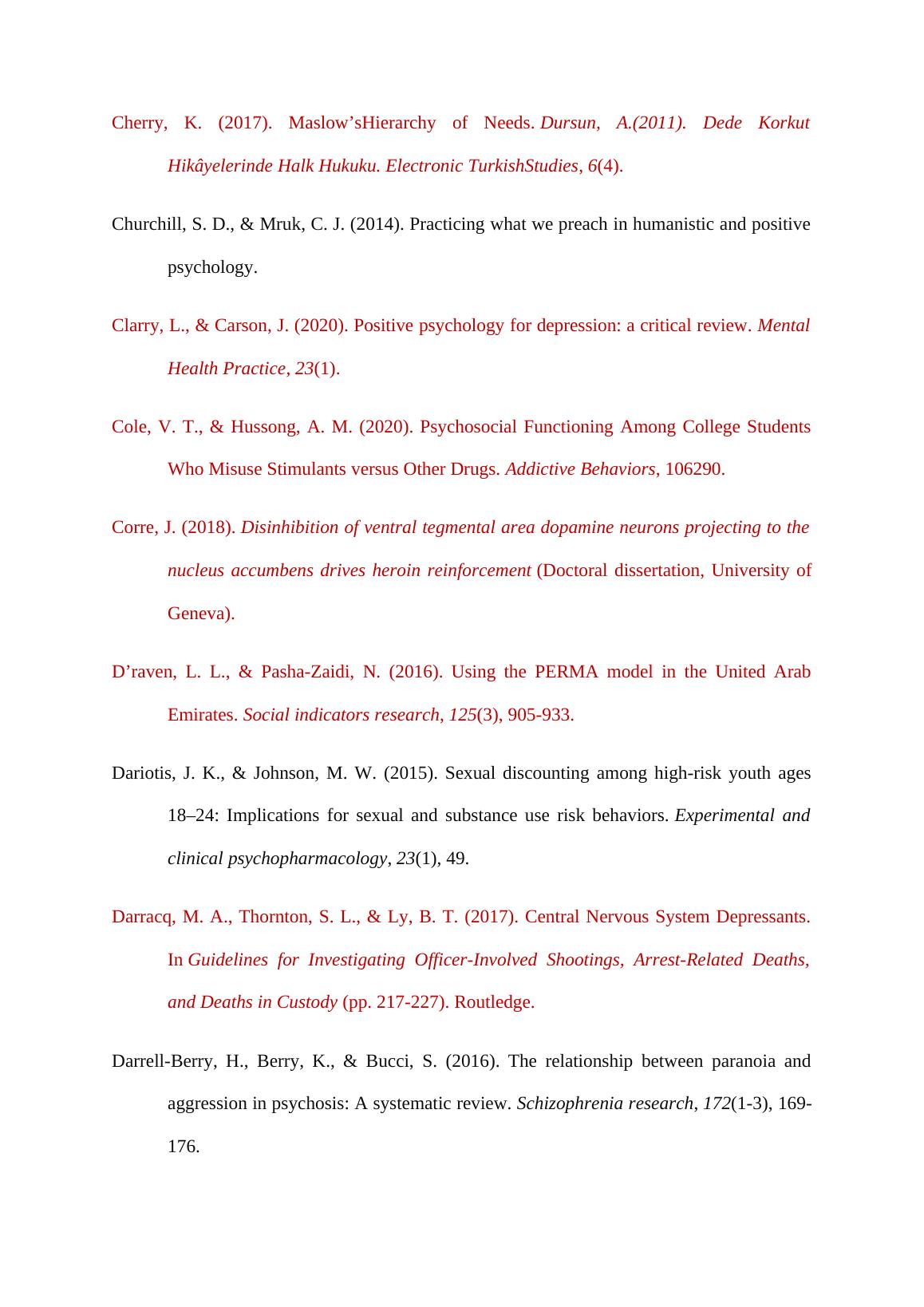Substance Abuse and Addiction: A Comprehensive Review
A capstone project on positive recovery in addiction and its impact on individual, family, and community well-being.
16 Pages5357 Words493 Views
Added on 2022-11-13
About This Document
This comprehensive review covers the latest research on substance abuse and addiction, including risk factors, treatment options, and recovery programs. Topics include predictors of substance abuse, factors associated with contingency management adoption, collegiate recovery programs, and more. Find essays, dissertations, and more on Desklib.
Substance Abuse and Addiction: A Comprehensive Review
A capstone project on positive recovery in addiction and its impact on individual, family, and community well-being.
Added on 2022-11-13
ShareRelated Documents
References
Abdoli, N., Farnia, V., Salemi, S., Tatari, F., Shakeri, J., Basanj, B., ... & Bahrampouri, S.
(2018). Predictors of substance abuse among risky drivers: The role of personality
characteristics and mental health. Journal of education and health promotion, 7.
Ali, B., Green, K. M., Daughters, S. B., & Lejuez, C. W. (2017). Distress tolerance interacts
with circumstances, motivation, and readiness to predict substance abuse treatment
retention. Addictive behaviors, 73, 99-104.
Arria, A. M., Caldeira, K. M., Allen, H. K., Bugbee, B. A., Vincent, K. B., & O’Grady, K. E.
(2017). Prevalence and incidence of drug use among college students: an 8-year
longitudinal analysis. The American journal of drug and alcohol abuse, 43(6), 711-
718.
Ashford, R. D., Brown, A. M., Eisenhart, E., Thompson-Heller, A., & Curtis, B. (2018).
What we know about students in recovery: meta-synthesis of collegiate recovery
programs. Retrieved from
https://www.researchgate.net/profile/Robert_Ashford4/publication/322521744_What_
we_know_about_students_in_recovery_meta-
synthesis_of_collegiate_recovery_programs_2000-2017/links/
5a5e1552458515c03ee09938/What-we-know-about-students-in-recovery-meta-
synthesis-of-collegiate-recovery-programs-2000-2017.pdf
Barker, S. L. (2018). Positive Psychology, Spirituality, and the Treatment of
Addictions. Social Work.
Abdoli, N., Farnia, V., Salemi, S., Tatari, F., Shakeri, J., Basanj, B., ... & Bahrampouri, S.
(2018). Predictors of substance abuse among risky drivers: The role of personality
characteristics and mental health. Journal of education and health promotion, 7.
Ali, B., Green, K. M., Daughters, S. B., & Lejuez, C. W. (2017). Distress tolerance interacts
with circumstances, motivation, and readiness to predict substance abuse treatment
retention. Addictive behaviors, 73, 99-104.
Arria, A. M., Caldeira, K. M., Allen, H. K., Bugbee, B. A., Vincent, K. B., & O’Grady, K. E.
(2017). Prevalence and incidence of drug use among college students: an 8-year
longitudinal analysis. The American journal of drug and alcohol abuse, 43(6), 711-
718.
Ashford, R. D., Brown, A. M., Eisenhart, E., Thompson-Heller, A., & Curtis, B. (2018).
What we know about students in recovery: meta-synthesis of collegiate recovery
programs. Retrieved from
https://www.researchgate.net/profile/Robert_Ashford4/publication/322521744_What_
we_know_about_students_in_recovery_meta-
synthesis_of_collegiate_recovery_programs_2000-2017/links/
5a5e1552458515c03ee09938/What-we-know-about-students-in-recovery-meta-
synthesis-of-collegiate-recovery-programs-2000-2017.pdf
Barker, S. L. (2018). Positive Psychology, Spirituality, and the Treatment of
Addictions. Social Work.

Becker, S. J., Kelly, L. M., Kang, A. W., Escobar, K. I., & Squires, D. D. (2019). Factors
associated with contingency management adoption among opioid treatment providers
receiving a comprehensive implementation strategy. Substance abuse, 40(1), 56-60.
Beeson, E. T., Whitney, J. M., & Peterson, H. M. (2017). The development of a collegiate
recovery program: Applying social cognitive theory within a social ecological
framework. American Journal of Health Education, 48(4), 226-239.
Behere, P. B., Das, A., & Behere, A. P. (2019). Sympathomimetics and Dopamine Receptor
Agonists (Psycho Stimulants). In Clinical Psychopharmacology (pp. 131-139).
Springer, Singapore.
Birch, H., Mcgann, D., & Riby, L. (2019). Perfectionism and PERMA: The benefits of other-
oriented perfectionism. International Journal of Wellbeing, 9(1), 20-42.
Birtel, M. D., Wood, L., & Kempa, N. J. (2017). Stigma and social support in substance
abuse: Implications for mental health and well-being. Psychiatry Research, 252, 1-8.
Bonnaire, C., Kovess-Masfety, V., Guignard, R., Richard, J. B., Du Roscoät, E., & Beck, F.
(2017). Gambling type, substance abuse, health and psychosocial correlates of male
and female problem gamblers in a nationally representative French sample. Journal of
Gambling Studies, 33(2), 343-369.
Brown, A. M., Ashford, R. D., Figley, N., Courson, K., Curtis, B., & Kimball, T. (2019).
Alumni characteristics of collegiate recovery programs: A national
survey. Alcoholism Treatment Quarterly, 37(2), 149-162.
Brown, A., Ashford, R., Heller, A. T., Whitney, J., & Kimball, T. (2018). Collegiate recovery
students and programs: Literature review from 1988-2017. Journal of Recovery
Science, 1(1), 1-11.
associated with contingency management adoption among opioid treatment providers
receiving a comprehensive implementation strategy. Substance abuse, 40(1), 56-60.
Beeson, E. T., Whitney, J. M., & Peterson, H. M. (2017). The development of a collegiate
recovery program: Applying social cognitive theory within a social ecological
framework. American Journal of Health Education, 48(4), 226-239.
Behere, P. B., Das, A., & Behere, A. P. (2019). Sympathomimetics and Dopamine Receptor
Agonists (Psycho Stimulants). In Clinical Psychopharmacology (pp. 131-139).
Springer, Singapore.
Birch, H., Mcgann, D., & Riby, L. (2019). Perfectionism and PERMA: The benefits of other-
oriented perfectionism. International Journal of Wellbeing, 9(1), 20-42.
Birtel, M. D., Wood, L., & Kempa, N. J. (2017). Stigma and social support in substance
abuse: Implications for mental health and well-being. Psychiatry Research, 252, 1-8.
Bonnaire, C., Kovess-Masfety, V., Guignard, R., Richard, J. B., Du Roscoät, E., & Beck, F.
(2017). Gambling type, substance abuse, health and psychosocial correlates of male
and female problem gamblers in a nationally representative French sample. Journal of
Gambling Studies, 33(2), 343-369.
Brown, A. M., Ashford, R. D., Figley, N., Courson, K., Curtis, B., & Kimball, T. (2019).
Alumni characteristics of collegiate recovery programs: A national
survey. Alcoholism Treatment Quarterly, 37(2), 149-162.
Brown, A., Ashford, R., Heller, A. T., Whitney, J., & Kimball, T. (2018). Collegiate recovery
students and programs: Literature review from 1988-2017. Journal of Recovery
Science, 1(1), 1-11.

Brown, T. K., & Alper, K. (2018). Treatment of opioid use disorder with ibogaine:
detoxification and drug use outcomes. The American journal of drug and alcohol
abuse, 44(1), 24-36.
Bugbee, B. A., Caldeira, K. M., Soong, A. M., Vincent, K. B., & Arria, A. M. (2016).
Collegiate recovery programs: A win-win proposition for students and
colleges. College Park, MD: Center on Young Adult Health and Development.
Busseri, M. A. (2015). Toward a resolution of the tripartite structure of subjective well‐
being. Journal of personality, 83(4), 413-428.
Caldeira, K. M., Arria, A. M., O’Grady, K. E., Vincent, K. B., Robertson, C., & Welsh, C. J.
(2017). Risk factors for gambling and substance use among recent college
students. Drug and alcohol dependence, 179, 280-290.
Calipari, E. S., Juarez, B., Morel, C., Walker, D. M., Cahill, M. E., Ribeiro, E., ... & Nestler,
E. J. (2017). Dopaminergic dynamics underlying sex-specific cocaine reward. Nature
communications, 8(1), 1-15.
Carhart-Harris, R. L., Kaelen, M., Bolstridge, M., Williams, T. M., Williams, L. T.,
Underwood, R., ... & Nutt, D. J. (2016). The paradoxical psychological effects of
lysergic acid diethylamide (LSD). Psychological medicine, 46(7), 1379-1390.
Cavanaugh, D. C. (2016). Examining Intrinsic Motivation and Holistic Functioning: The
Role of Therapeutic Recreation in Residential Substance Use Treatment.
Chang, S. W., Wellmerling, J., Zhang, X., Rayner, R. E., Osman, W., Mertz, S., ... & Cormet-
Boyaka, E. (2018). The psychoactive substance of cannabis Δ9-tetrahydrocannabinol
(THC) negatively regulates CFTR in airway cells. Biochimica et Biophysica Acta
(BBA)-General Subjects, 1862(9), 1988-1994.
detoxification and drug use outcomes. The American journal of drug and alcohol
abuse, 44(1), 24-36.
Bugbee, B. A., Caldeira, K. M., Soong, A. M., Vincent, K. B., & Arria, A. M. (2016).
Collegiate recovery programs: A win-win proposition for students and
colleges. College Park, MD: Center on Young Adult Health and Development.
Busseri, M. A. (2015). Toward a resolution of the tripartite structure of subjective well‐
being. Journal of personality, 83(4), 413-428.
Caldeira, K. M., Arria, A. M., O’Grady, K. E., Vincent, K. B., Robertson, C., & Welsh, C. J.
(2017). Risk factors for gambling and substance use among recent college
students. Drug and alcohol dependence, 179, 280-290.
Calipari, E. S., Juarez, B., Morel, C., Walker, D. M., Cahill, M. E., Ribeiro, E., ... & Nestler,
E. J. (2017). Dopaminergic dynamics underlying sex-specific cocaine reward. Nature
communications, 8(1), 1-15.
Carhart-Harris, R. L., Kaelen, M., Bolstridge, M., Williams, T. M., Williams, L. T.,
Underwood, R., ... & Nutt, D. J. (2016). The paradoxical psychological effects of
lysergic acid diethylamide (LSD). Psychological medicine, 46(7), 1379-1390.
Cavanaugh, D. C. (2016). Examining Intrinsic Motivation and Holistic Functioning: The
Role of Therapeutic Recreation in Residential Substance Use Treatment.
Chang, S. W., Wellmerling, J., Zhang, X., Rayner, R. E., Osman, W., Mertz, S., ... & Cormet-
Boyaka, E. (2018). The psychoactive substance of cannabis Δ9-tetrahydrocannabinol
(THC) negatively regulates CFTR in airway cells. Biochimica et Biophysica Acta
(BBA)-General Subjects, 1862(9), 1988-1994.

Cherry, K. (2017). Maslow’sHierarchy of Needs. Dursun, A.(2011). Dede Korkut
Hikâyelerinde Halk Hukuku. Electronic TurkishStudies, 6(4).
Churchill, S. D., & Mruk, C. J. (2014). Practicing what we preach in humanistic and positive
psychology.
Clarry, L., & Carson, J. (2020). Positive psychology for depression: a critical review. Mental
Health Practice, 23(1).
Cole, V. T., & Hussong, A. M. (2020). Psychosocial Functioning Among College Students
Who Misuse Stimulants versus Other Drugs. Addictive Behaviors, 106290.
Corre, J. (2018). Disinhibition of ventral tegmental area dopamine neurons projecting to the
nucleus accumbens drives heroin reinforcement (Doctoral dissertation, University of
Geneva).
D’raven, L. L., & Pasha-Zaidi, N. (2016). Using the PERMA model in the United Arab
Emirates. Social indicators research, 125(3), 905-933.
Dariotis, J. K., & Johnson, M. W. (2015). Sexual discounting among high-risk youth ages
18–24: Implications for sexual and substance use risk behaviors. Experimental and
clinical psychopharmacology, 23(1), 49.
Darracq, M. A., Thornton, S. L., & Ly, B. T. (2017). Central Nervous System Depressants.
In Guidelines for Investigating Officer-Involved Shootings, Arrest-Related Deaths,
and Deaths in Custody (pp. 217-227). Routledge.
Darrell-Berry, H., Berry, K., & Bucci, S. (2016). The relationship between paranoia and
aggression in psychosis: A systematic review. Schizophrenia research, 172(1-3), 169-
176.
Hikâyelerinde Halk Hukuku. Electronic TurkishStudies, 6(4).
Churchill, S. D., & Mruk, C. J. (2014). Practicing what we preach in humanistic and positive
psychology.
Clarry, L., & Carson, J. (2020). Positive psychology for depression: a critical review. Mental
Health Practice, 23(1).
Cole, V. T., & Hussong, A. M. (2020). Psychosocial Functioning Among College Students
Who Misuse Stimulants versus Other Drugs. Addictive Behaviors, 106290.
Corre, J. (2018). Disinhibition of ventral tegmental area dopamine neurons projecting to the
nucleus accumbens drives heroin reinforcement (Doctoral dissertation, University of
Geneva).
D’raven, L. L., & Pasha-Zaidi, N. (2016). Using the PERMA model in the United Arab
Emirates. Social indicators research, 125(3), 905-933.
Dariotis, J. K., & Johnson, M. W. (2015). Sexual discounting among high-risk youth ages
18–24: Implications for sexual and substance use risk behaviors. Experimental and
clinical psychopharmacology, 23(1), 49.
Darracq, M. A., Thornton, S. L., & Ly, B. T. (2017). Central Nervous System Depressants.
In Guidelines for Investigating Officer-Involved Shootings, Arrest-Related Deaths,
and Deaths in Custody (pp. 217-227). Routledge.
Darrell-Berry, H., Berry, K., & Bucci, S. (2016). The relationship between paranoia and
aggression in psychosis: A systematic review. Schizophrenia research, 172(1-3), 169-
176.

End of preview
Want to access all the pages? Upload your documents or become a member.
